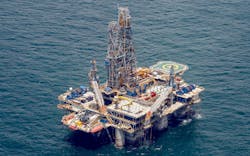Offshore drilling market adapting through consolidation, collaboration
The offshore drilling market is slowly recovering from the COVID-19 pandemic and oil price crash. Several drilling rig contractors and analysts have reported seeing early signs of a recovery and pickup in activity as the year goes on. Operators are said to be accelerating drilling programs in order to take advantage of low rig rates in anticipation of a tighter supply/demand balance.
Meanwhile, rig contractors and managers are still working to pare back their fleets to be in line with market demand. According to Rystad Energy, an evaluation of active rigs in the global floater fleet (as of late 2020) revealed that up to 59 of the 213 units are potential candidates for retirement. This equates to one-quarter of the floater segment, or 22 drillships and 37 semisubmersibles.
Jo Friedmann, vice president, Energy Service Research, at Rystad, said: “Capacity attrition can set the stage for a comeback in utilization and play a key role as the offshore drilling industry seeks to shore up its finances.”
Rig supply needs to tighten for drilling contractors to regain pricing power, Friedmann added.
From corporate and asset M&A transactions, to joint ventures and rig management and operating partnerships, consolidation is under way in the offshore drilling market.
A changing landscape
As many offshore drilling contractors emerge from Chapter 11 bankruptcy, long-term stacked and older rig retirements are expected to increase.
In April, Noble Corp. acquired Pacific Drilling Co. LLC in an all-stock transaction. According to Noble, the acquisition facilitates its reentry into the growing West Africa and Mexico regions and strengthens its presence in the US Gulf of Mexico. Also, it is hoped that the addition of Pacific’s ultra-deepwater drillships will allow participation in key tendering activity. The company immediately retired the Pacific Bora and Pacific Mistral.
The drilling contractor now owns and operates a high-specification fleet of 24 offshore drilling rigs: 11 drillships, one semisubmersible, and 12 jackups.
Last year, the company retired the 1981-built jackup Noble Joe Beall, and sold the cold-stacked drillships Noble Bully I and Noble Bully II and the semisubmersibles Noble Jim Day, Noble Danny Adkins, and Noble Paul Romano.
Terry Childs, Head of Westwood Energy’s RigLogix, said: “Whether any other deals take place remains to be seen, but it is possible that the changing landscape could mark the end of some of the biggest names in the history of the offshore rig market, joining the likes of Rowan, ENSCO, and GlobalSantaFe.”
As for other rig contractors, Diamond Offshore Drilling Inc. and Valaris both completed financial restructuring in April and May 2021, respectively.
Valaris has sold and retired three drillships (DS-3, DS-5, and DS-6), five semisubmersibles (5004, 8500, 8501, 8502, and 8504), and six jackups (JU-71, JU-84, JU-87, JU-88, JU-101, and JU-105). Its fleet now consists of 11 drillships, five semisubmersibles, and 44 jackups.
Seadrill and some of its consolidated subsidiaries filed for Chapter 11 bankruptcy in February 2021.
Last year Seadrill announced it would scrap or offer for sale up to 10 rigs, legacy units that no longer offer sufficient returns on investment. As part of this initiative, the company sold the cold-stacked jackup West Epsilon to Well-Safe Solutions.
Vantage Drilling International has entered into a framework agreement and related management and marketing agreements with Seadrill Partners. Vantage will provide operating, management, and marketing services for the drillships West Polaris and West Capella and the semisubmersibles West Leo and West Sirius.
Vantage also sold the drillship Titanium Explorer, and it is expected to be recycled soon.
In addition, Transocean has retired the semisubmersible Leiv Eiriksson, and Shelf Drilling has sold the jackups Trident 15, Galveston Key, and Key Hawaii.
Maersk Drilling has sold the warm-stacked jackup Maersk Guardian (now re-named Guardian) to New Fortress Energy, and is close to an agreement to sell the cold-stacked jackup Mærsk Gallant to the same buyer. Total sales price for the two rigs is $31 million. New Fortress Energy plans to use the rigs for non-drilling purposes, as part of its planned Fast LNG project.
Once the two transactions have closed, Maersk Drilling’s fleet will consist of 12 jackups, 11 of which are suited for harsh-environment operations, and eight floaters.
Collaboration heats up
Downhole service providers are also adapting to the new environment, mainly through consolidation and collaboration.
Baker Hughes and Akastor ASA have agreed to create a 50/50 joint venture company that is expected to deliver a global full-service offshore drilling equipment offering. The company will bring together Baker Hughes’ Subsea Drilling Systems business with Akastor’s wholly owned subsidiary MHWirth AS. The closing of the transaction is subject to customary conditions, including regulatory approvals, and is expected to occur in the second half of 2021.
Schlumberger and NOV have agreed to collaborate to accelerate automated drilling solutions adoption by oil and gas operators and drilling contractors. The agreement will enable customers to combine Schlumberger’s surface and downhole drilling automation solutions with NOV’s rig automation platform. This integrated offering is said to enable the automation of manual workflows, improving safety, decision making, consistency, and efficiency in drilling.
The combined solution leverages advanced AI from the Schlumberger DrillOps on-target well delivery solution, while NOV’s NOVOS process-automation platform controls all the company’s rig equipment within the operational envelope. The two technologies will work together to manage compliance to procedure and to reach best-in-class operational performance, the companies claimed.
Also, Weatherford has teamed up with Safe Influx to offer automated downhole solutions. Under a recent memorandum of understanding, the companies say they will cooperate to bring to market the first-ever integration of managed pressure drilling (MPD) solutions and automated well control technology.
As part of the MoU, Safe Influx will combine its automated well control technology with Weatherford’s portfolio of MPD products and services. The companies said that this integrated offering will automate the mitigation of hazards while drilling in the most efficient manner possible.
The companies recently completed the rig trial of what they claimed is the industry’s first ever integration of MPD and automated well control technology. The combination of Weatherford’s Victus intelligent MPD and Safe Influx’s technology is said to provide automated secondary well control which is expected to allow wells to be drilled and constructed more efficiently.





